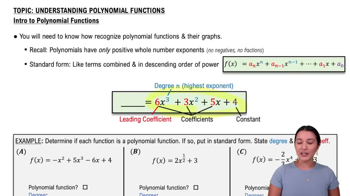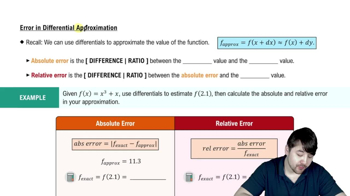Table of contents
- 0. Functions7h 52m
- Introduction to Functions16m
- Piecewise Functions10m
- Properties of Functions9m
- Common Functions1h 8m
- Transformations5m
- Combining Functions27m
- Exponent rules32m
- Exponential Functions28m
- Logarithmic Functions24m
- Properties of Logarithms34m
- Exponential & Logarithmic Equations35m
- Introduction to Trigonometric Functions38m
- Graphs of Trigonometric Functions44m
- Trigonometric Identities47m
- Inverse Trigonometric Functions48m
- 1. Limits and Continuity2h 2m
- 2. Intro to Derivatives1h 33m
- 3. Techniques of Differentiation3h 18m
- 4. Applications of Derivatives2h 38m
- 5. Graphical Applications of Derivatives6h 2m
- 6. Derivatives of Inverse, Exponential, & Logarithmic Functions2h 37m
- 7. Antiderivatives & Indefinite Integrals1h 26m
- 8. Definite Integrals4h 44m
- 9. Graphical Applications of Integrals2h 27m
- 10. Physics Applications of Integrals 2h 22m
4. Applications of Derivatives
Differentials
Problem 4.8.58d
Textbook Question
{Use of Tech} Fixed points of quadratics and quartics Let f(x) = ax(1 -x), where a is a real number and 0 ≤ a ≤ 1. Recall that the fixed point of a function is a value of x such that f(x) = x (Exercises 48–51).
d. Find the number and location of the fixed points of g for a = 2, 3, and 4 on the interval 0 ≤ x ≤ 1.
 Verified step by step guidance
Verified step by step guidance1
Understand the concept of a fixed point: A fixed point of a function f(x) is a value x such that f(x) = x. This means that when you substitute x into the function, the output is the same as the input.
Set up the equation for fixed points: For the function f(x) = ax(1 - x), we need to solve the equation ax(1 - x) = x to find the fixed points.
Rearrange the equation: Start by expanding the left side to get ax - ax^2 = x. Then, move all terms to one side to form a quadratic equation: ax - ax^2 - x = 0.
Factor the quadratic equation: Factor the equation ax - ax^2 - x = 0 to find the values of x. This can be done by factoring out x, giving x(a - ax - 1) = 0.
Solve for x: The factored equation x(a - ax - 1) = 0 gives two potential solutions: x = 0 and a - ax - 1 = 0. Solve the second equation for x to find the other fixed points, and analyze these solutions for different values of a (2, 3, and 4) within the interval 0 ≤ x ≤ 1.
 Verified video answer for a similar problem:
Verified video answer for a similar problem:This video solution was recommended by our tutors as helpful for the problem above
Video duration:
6mPlay a video:
Was this helpful?
Key Concepts
Here are the essential concepts you must grasp in order to answer the question correctly.
Fixed Points
A fixed point of a function f(x) is a value x such that f(x) = x. This means that when the function is applied to this value, it returns the same value. Finding fixed points often involves solving the equation f(x) - x = 0. In the context of the given function, identifying fixed points helps understand the behavior of the function within a specified interval.
Recommended video:

Critical Points
Quadratic and Quartic Functions
Quadratic functions are polynomial functions of degree two, typically expressed in the form f(x) = ax^2 + bx + c. Quartic functions are of degree four, represented as f(x) = ax^4 + bx^3 + cx^2 + dx + e. The behavior of these functions, including their fixed points, can be analyzed using their graphs, derivatives, and algebraic properties, which are essential for solving the problem at hand.
Recommended video:

Introduction to Polynomial Functions
Interval Analysis
Interval analysis involves examining the behavior of functions within a specific range, in this case, 0 ≤ x ≤ 1. This is crucial for determining the existence and location of fixed points, as the function's behavior may vary significantly outside this interval. By restricting the analysis to a defined interval, one can apply techniques such as the Intermediate Value Theorem to ascertain the number of fixed points.
Recommended video:

Derivatives Applied To Velocity







